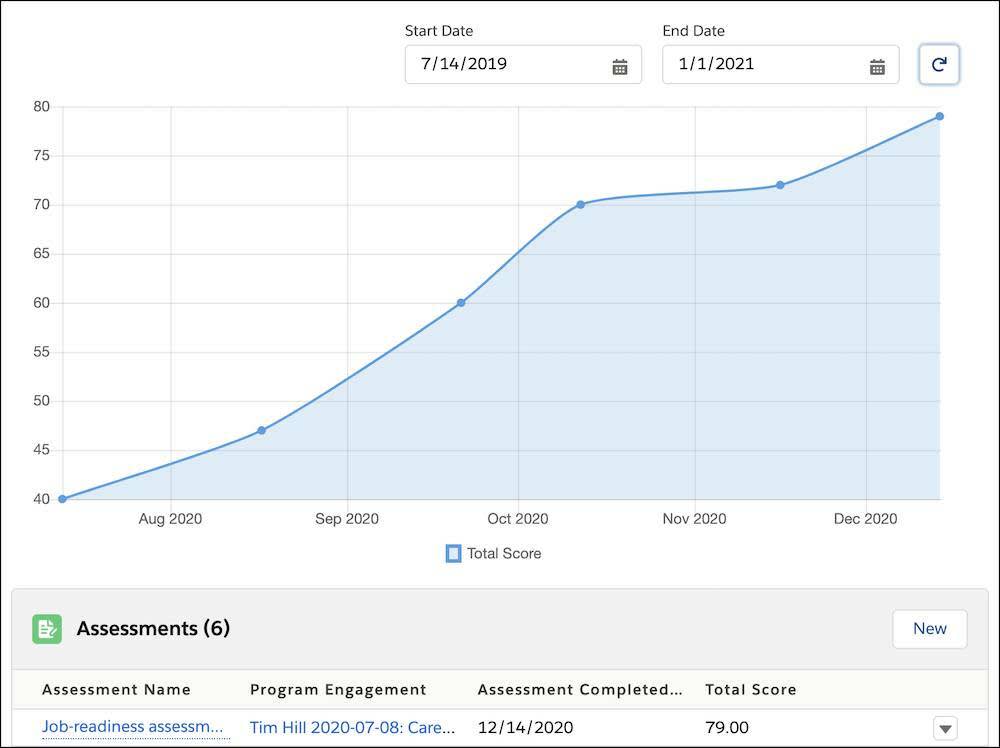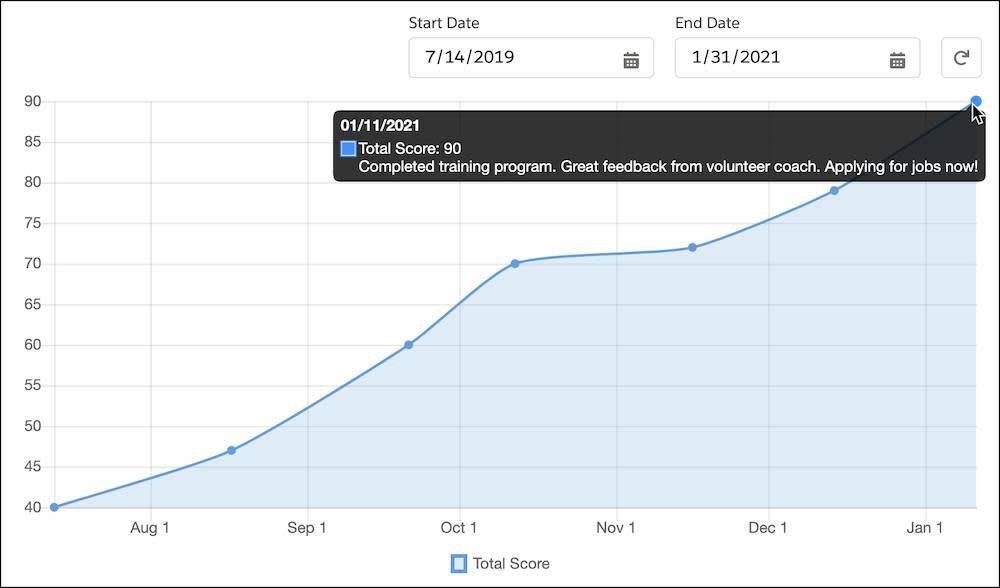Record Client Assessments
Learning Objectives
After completing this unit, you’ll be able to:
- Record assessments on a client record.
- Work with your admin to configure assessment scores.
Measure Progress Toward Goals
No More Homelessness (NMH) client Tim Hill moved into transitional housing and is well on his way through the career counseling program. He decided he wants to work in the construction trades and is completing a training program while working with NMH on other services.
Tim’s case manager, Rosa Sanchez, is happy to see Tim’s progress—and since NMH is a data-driven organization, she needs to record and quantify it beyond completed items on Tim’s case plan.
That's exactly what assessments do in Case Management.

Understand Assessments
Assessments help case managers determine which path to take with a client, and then measure their progress along that path. Assessments tend to happen at key milestones: during intake, in the middle of an engagement, and at the end of a program to measure growth.
Assessment sources vary depending on an organization’s goals and established processes. For example, one organization may focus on collecting data through conversations, while another may use surveys or tests, look at background information about engagements, or use a combination of these options. The assessment tool in Case Management is designed to be flexible enough to meet many different needs.
The assessment tool includes the ability to set scores. Out of the box, there is one assessment score enabled (a field labeled Total Score) that records a number, like a percentage grade or a rating on a 10-point scale.
If your organization uses several scores for one assessment—like a literacy assessment that includes separate scores for word recognition, reading comprehension, and verbal language—your admin can customize the tool to include additional score fields for different types of assessments.
If your organization doesn’t use scores on assessments, leave the score blank and enter other data, such as comments and completed dates, and relate the assessment to a program.
At our example organization, NMH decided to use a single score for its job-readiness assessments in the career counseling program. Rosa talks with Tim and his job-readiness coach at least one time each month and, based on NMH criteria, gives Tim a score out of 100 on his overall job readiness.
Track Progress Over Time
One benefit of assessments is the ability to track progress over time. At NMH, Rosa tracked Tim’s progress for the past 6 months through monthly job-readiness assessments.
To check on Tim’s progress, Rosa goes to his contact record and navigates to the Assessment tab. Rosa can track Tim’s progress toward the goal because Case Management displays all of his scores in a handy graph.

Rosa can tell that Tim is growing his job readiness skills because the assessment scores have increased steadily over time. (If NMH was using more than one type of assessment, and it was assigned to Tim, Rosa could toggle between these views from the chart.)
Below the chart is an assessment list, which includes scores and completed dates. To open any of the assessment records, Rosa clicks the assessment name.
Enter Assessment Scores
Now that Rosa knows how Tim is doing, it’s time to create an assessment score. Rosa is currently on Tim’s contact record and on the Assessment tab, so she clicks New in the assessments related list.
- Enter the assessment name. NMH has agreed to a convention of naming the assessment with the client’s name, assessment type, and date, so Rosa names the record following that pattern.
- Set an assessment completed date.

- Find and select a related program engagement. Because this assessment relates directly to Tim’s program engagement with the career counseling program, Rosa finds and selects that record.
- Enter a score. Tim passed a few major milestones, so, according to NMH’s scoring checklist, Rosa can now enter
90in the assessment score. Good job, Tim! - Enter any additional comments. Rosa adds a few. Most of her thoughts are already collected in notes associated with Tim's contact and program engagement records, but she wants to add a progress reminder here, too. The comments also appear on the graph when Rosa hovers over an assessment score.

- Click Save to create the assessment.
The assessments chart doesn’t automatically update, so Rosa checks the date range and clicks Refresh (![]() ) in the chart area.
) in the chart area.

If the assessment had several scores, Rosa could turn scores off and on by clicking the labels in the key at the bottom of the chart to focus on just one of Tim’s assessment scores.
Rosa can tell where Tim is headed if he keeps up the hard work and gets continuing support in the career counseling program. The other programs are helping him achieve his goals, too. If he continues to progress, Tim will be ready for a new job and a move into a home of his own soon.
Rosa pauses a moment to celebrate Tim’s progress—and then a glance at her watch tells her that now it’s time to move on to another client. So, back to Client Search at the bottom of the page...

